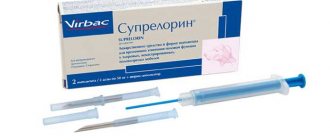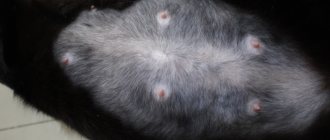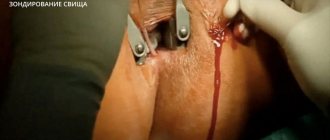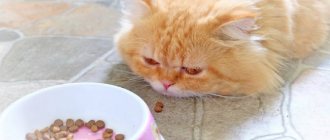Postoperative care is the most important aspect of sterilization of cats, since after the operation all care for the animal rests with the owners. The most pressing question for many remains how long to wear a blanket after sterilizing a cat. The main problem is that animals refuse to wear a protective bandage and try with all their might to free themselves from it. Looking at the suffering of their pets, the owners try to remove the bandage early, without even realizing that such a decision is not always the right one.
When can you remove the blanket?
A bandage (blanket) tied on the back is used to protect the sutures on the abdomen placed in the clinic during surgery.
The healing period of the suture is extremely important for the future health of the cat.
Sometimes it is possible to remove the blanket from a cat after sterilization already on the second day after the operation, but if emergency situations arise, the period of wearing the bandage can increase to 10 days or more.
The main problem when wearing a protective device can be considered that the tailed pet protests with all his might against putting it on , tries to get rid of it, seems very unhappy, which causes the owner a natural desire to make the cat’s life easier. But there are a number of nuances that affect the period of wearing the bandage.
Choosing a product in the store
When choosing a product in a store, you need to know the size of your pet. The packaging should not be opened for hygiene reasons. If the seller offers opened packaging, refuse such a product. There are three sizes: small (S), medium (M) and large (L). The main measurements are the distance from the base of the tail to the base of the neck and chest circumference.
The blanket should fit snugly to the body, but at the same time make the animal comfortable. The fasteners can be ties or Velcro. In the case of Velcro, this is convenient when the cat is short-haired and the hair will not get on it.
The advantage of ties is the ability to slightly increase the size, for example, if the animal has gained a little weight.
When purchasing, it is better to choose a lighter color of the fabric. This way you can easily determine when it’s time to change the bandage.
We recommend purchasing a replacement version immediately. When choosing, carefully inspect the stitching of the product: there should be no protruding threads. Even the smallest thread, if caught in a seam, can cause fester. The ties are wide and firmly stitched. The kit should include instructions on how to properly tie a blanket on a cat.
In case of non-standard body proportions or in order to save money, you can easily sew a blanket for a cat with your own hands.
What affects the duration of wearing a blanket?
The number of days directly depends on the method in which the postoperative sutures were processed.
Types of processing:
- Using a protective spray. This method of treating a postoperative suture protects the wound from the development of inflammatory processes, accelerates the healing process, has a beneficial effect on overall well-being, and reduces the period of wearing protection to 7 days.
- Without using protective spray. In this case, we are talking about a time interval from a week to 10 days, it all depends on the condition of the animal and the speed of healing of the skin.
Be sure to read:
After sterilization, a cat sleeps a lot and is lethargic: normal or pathological, what consequences may occur after surgery
The protective bandage is made from natural fabrics (cotton), does not irritate the animal’s skin, does not allow the cat to lick the wound, protects against inflammation of the seam, but causes some discomfort to the pet.
Your furry pet may notice changes in behavior or gait, but as soon as the protection is removed, everything will be restored.
Important! Many owners independently decide when to remove the blanket after surgery, based on the fact that the cat is hampered by the protective bandage. If the bandage is removed without the advice of a veterinarian, it is necessary to constantly monitor the pet. You can use a special collar that will prevent the animal from licking the seam.
How many days to wear
If you put on the blanket correctly, the animal will quickly get used to the new item of clothing. But it happens that the cat is constantly unhappy and tries to remove it. And then the owners are tempted to remove this bandage that limits mobility. Don't let the animal pressure you into pity.
It is very important to wear the blanket for as long as necessary for healing. Only a veterinarian can determine exactly when the protection can be removed, but this is usually done two to three days after the external sutures are removed.
When is it possible to remove the protective device early?
The protective bandage is made from natural fabrics (cotton) and does not irritate the animal’s skin
. Early removal is possible if:
- the surgical intervention was carried out using laparoscopy: in this case, the wound is so small that protection is not required;
- when performing sterilization, the surgeon used absorbable suture material and protective sprays to treat the wound;
- Four days after the operation, the cat has a normal body temperature, there is no bleeding, redness of the suture, or suppuration.
Important! When using suture material that requires further removal, you should not remove the bandage ahead of time, even if it causes discomfort to the animal.
After examining your pet, the doctor may recommend getting rid of the protective accessory ahead of schedule if:
- aggression is clearly expressed, the animal continuously tears off and gnaws the blanket;
- the animal is afraid to walk in a bandage;
- ulcerations appeared under the places where the tissue puts maximum pressure on the body;
- the bandage became very dirty due to eating and visiting the toilet.
What to replace it with?
If a person is not comfortable with sewing, then for such work he will need children's clothing in the form of a bodysuit. You can make a blanket from scrap materials. If the animal is small, a belt made from a sock will do.
It is important to remember that the sock must be completely new and never used. Slots are made in the designated places through which the paw can be inserted
However, such a blanket is unreliable because it can be easily removed.
For an adult cat, a blanket made from tights is suitable
It is important that the product has increased density. In addition to tights, you can use a pant leg or sleeve cut off from unnecessary clothing
As in the version with a sock, holes for the limbs are cut in the required places. A good option that replaces the cat wrap is a baby bodysuit.
Observation after removal of the bandage
After the bandage is removed, it is necessary to carefully monitor the cat's condition in the first days. The cat family is characterized by increased cleanliness, therefore, at first the animal will constantly lick the seam.
The owner must ensure that the cat does not chew the edges of the healed wound.
Be sure to read:
Complications after castration of a cat: causes, types, symptoms and treatment, when you need to see a doctor
Important points during inspection:
- monitor the integrity of the edges of the wound surface;
- control whether there is any discharge from the wound in the form of blood or lymph;
- inspect the seam for redness, inflammation, and the appearance of purulent discharge;
- check whether nodes or swellings have appeared along the edges of the wound surface.
Any of the identified anomalies is a reason for an unscheduled visit to the veterinarian.
How to properly and safely tie a blanket on a cat after sterilization
To make it comfortable for your cat to wear a bandage, you need to learn how to tie it correctly. First of all, you need to lay your furry pet on its side, bring the edges of the bandage together and, starting from the top point, tie it with ties.
For better fastening of the blanket, the second garters are tied diagonally with the third. The penultimate and last ties are also tied using the crosswise method. The blanket should not dangle too much or squeeze the animal’s body. Ideally, your little finger should fit between the bandage and the blanket.
Processing and removal of seams
The sterilization operation is carried out under anesthesia; the owner needs not only to properly remove the animal from this state (properly contain, feed, give water), but also take care of the cleanliness of the wound.
The procedure for treating sutures begins on the third day after sterilization
The procedure for treating sutures begins on the third day after sterilization, at intervals of 2 times a day.
Algorithm of actions:
- Calm the beast, remove the bandage.
- Use a cotton swab soaked in an antiseptic (without alcohol) to generously moisten the wound surface with gentle movements.
- Remove hairs and dried blood.
- Inspect for inflammatory processes.
- Put on a bandage.
Attention! In some cases, to speed up healing, cat owners apply iodine or brilliant green to the stitches. It is strictly not recommended to do this: the drugs dry out the edges of the wound, inhibit recovery processes, and can lead to chemical burns of the skin.
Mammary tumor in cats
The incidence of mammary tumors in cats is slightly lower than in dogs and humans, but is still quite high and accounts for 17% of all feline neoplasms. For males it is 1%. The peak incidence occurs at 10 years of age.
Hormone dependence
Everything is about the same as in dogs. Early sterilization significantly reduces the risk of developing breast cancer
According to studies that did not take into account the age of sterilization, but only its fact: AMF in sterilized cats occurs 2 times less than in non-sterilized ones. However, it is worth noting that most of the cats in the study were neutered before they were six years old. The use of synthetic analogues of progesterone and estrogen increases the risk of developing tumors
ESPECIALLY MALES!!
Regarding other factors (genetic), everything is the same as in dogs. And it has no practical significance at this stage of development of veterinary medicine.
Usually animals with a single neoplasm or multiple ones (approximately 50/50) are admitted. In many cases there is invasion into the skin or underlying floaters and in 20% there is ulceration. In advanced cases, and this is often, despite the availability of information, there are detectable metastases in regional lymph nodes, or distant metastases in parenchymal organs, lungs, pleura, diaphragm or adrenal glands. Pleural carcinomatosis with pleural effusion and, as a consequence, the development of dyspnea in the animal are not uncommon.
Literature
- Belyaev A.N., Kozlov S.A., Taratykov I.B., Novikov E.I. Patient care in a surgical clinic: textbook. allowance. – Saransk: Mordovian University Publishing House, 2003. – 136 p.
- Buyanov V. M. Egiev V. N. Udotov O. A. Surgical suture. – M.: Antis, 2000. – 92 p.
- Zoltan J. Operating technique and conditions for optimal wound healing. – Budapest: Publishing House of the Academy of Sciences of Hungary, 1983. – 175 p.
- Mironova E. N. Fundamentals of physical rehabilitation. – M.: MOO “Academy of Safety and Survival”, 2016 – 310 p.
- Semenov G.M., Petrishin V.L., Kovshova M.V. Surgical suture - St. Petersburg: Peter, 2001. - 256 p.











